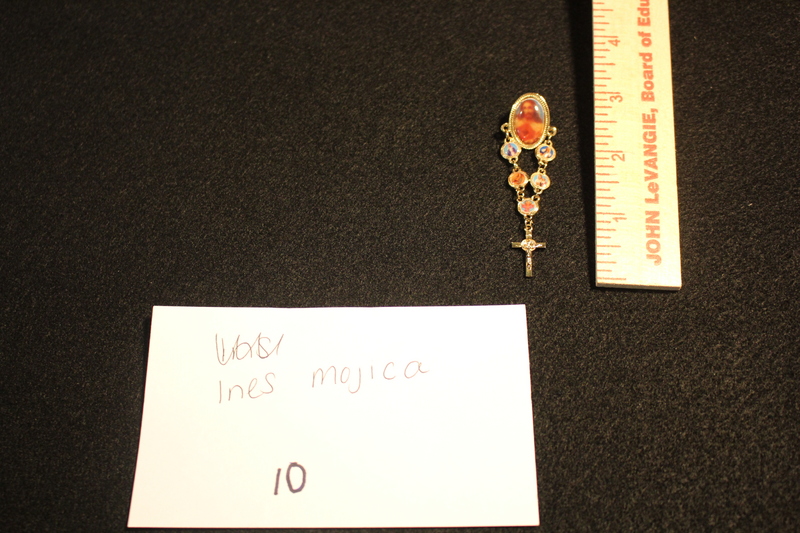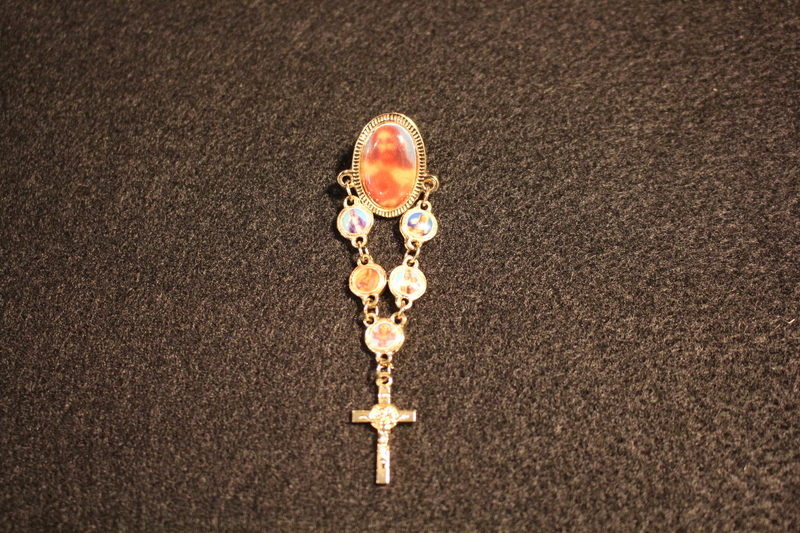Rosary Pin
Title
Subject
Catholic Church—Prayers and devotions
Catholic women
Puerto Rican Catholics
Puerto Rican women
Rosary
Description
Contributor, and St. Mary parishioner, Ines Mojica, brought in a beautiful and ornate Rosary Pin that was a gift from her dear friend, Aglae Luciano. Aglae, who passed about a month ago, brought the pin as a gift from Puerto Rico approximately five years ago. She wanted to present her friend Ines with a special gift that helped to express her love and devotion to both her friend and the Church.
Rosary beads are used in the Catholic faith as a method for members to devoutly pray. In an interview with Sean Baker, owner of Patrick Baker & Sons, Inc., a respected purveyor of religious supplies, Sean describes that traditionally, Rosaries may take the form of a strand, a pin, or a bracelet. The most common form, the strand, is held in the hands and prayers are recited in a clockwise direction, as each bead is held between the thumb and forefinger. The Holy Rosary represents 20 Mysteries of Faith, divided into decades of prayers starting with the “Glory Be”, the “Our Father”, and ten recitations of the “Hail Mary”. In smaller representations of the Holy Rosary, as in the pin brought in by Ines Mojica, the same number of prayers are recited, though the number of beads are less.
“The Catholic Church remains one of the Hispanics’ major cultural institutions. Nearly four-fifths of the Hispanics in the United States are Catholics.” The Catholic faith is a treasured part of the Puerto Rican Culture that both Ines and her friend Aglae brought with them as they moved to the United States. At the request of Ines, and in the memory of her dear friend, memories and sentiments were sought from Father Israel Rivera of Saint Mary’s Church on the love, compassion and selflessness that exemplified Aglae Luciano. “Always thinking of others and very involved in her community,” were the first thoughts that came to Father Israel. “She had a very strong faith and loved all. Aglae made time to visit the sick and cooked for so many others. She led the Ministry of “The Ladies of the Sacred Heart of Jesus” at the St. Mary Parish of New Britain. She was very happy to serve others and the Church. Her Sisters miss her very much, ‘Dearly’.” As we have learned in class and through our readings, when immigrant communities come together, whether through social or religious organizations, change and progress for an improved way of life start to manifest within the community. For example, “Groupes formed under the auspices of the Catholic Church in Waterbury and other cities played important roles in the growing of Puerto Rican communities. They brought church and related services to the people. Clergy and congregation members got babies baptized, taught catechism, and helped Spanish –speakers solve housing, job and other problems. They encouraged Puerto Ricans to celebrate feast days for the patron saints of their hometowns and other vernacular holidays.”
Included in the interview with Ines Mojica were some personal memories of moving to the United States, some 58 years ago in 1960. Ines originally moved to Miami with her husband and infant daughter. Several years later they moved to New Jersey where she bore another daughter, and soon thereafter moved to New Britain, Connecticut where she had relatives that were already established and welcomed her. As we learned this semester throughout our readings and specifically discussed in Llana Barber’s Latino City: Immigration and Urban Crisis in Lawrence, Massachusetts, 1945-2000, Ines’ story is a classic example of ‘chain migration’, very common of the Latino Immigration experience as well as other immigrant populations. Ines shared that in New Britain she added two more children to her family, though her son died in infancy.
While living in New Britain, Ines worked at Fafnir Bearing for 21 years, and the experience making bearings there helped her secure a position at Pratt & Whitney Aircraft in Southington. Ines worked at Pratt & Whitney for 17 years, until her retirement. Immigrating to the nation’s cities and urban centers, many Latinos found work in America’s changing industrial and manufacturing economy. Like the shoe manufacturing employment offered in Lawrence, Massachusetts, New Britain offered a declining, yet well, and long-established history of industrial manufacturing jobs. Ines is proud of her career in industry and manufacturing and the life it has provided her. She is currently enjoying her retirement, along with her 2nd husband with whom she has just celebrated their 35th wedding anniversary.
Ines Mojica, Personal Interview, CCSU History Harvest, Conducted by Paul Zapatka, April 29, 2018, St. Mary’s Church, New Britain, Connecticut.
Sean Baker, Personal Interview, Conducted by Paul Zapatka, May 5, 2018, Patrick Baker & Sons, Inc., Southington, Connecticut.
Duignan, Peter J. and L.H. Gann. The Spanish Speakers in the United States. (New York: University of America Press, 1998), 267.
Father Israel Rivera, Personal Phone Interview, conducted by Paul Zapatka, May 7, 2018.
Father Israel Rivera, Personal Phone Interview, conducted by Paul Zapatka, May 7, 2018.
Glasser, Ruth., Aqui Me Quedo: Puerto Ricans in Connecticut. Hartford: Connecticut Humanities Council, 1997.
Barber,Llana. Latino City: Immigration and Urban Crisis in Lawrence, Massachusetts, 1945-2000. Chapel Hill: The University of North Carolina Press, 2017.

